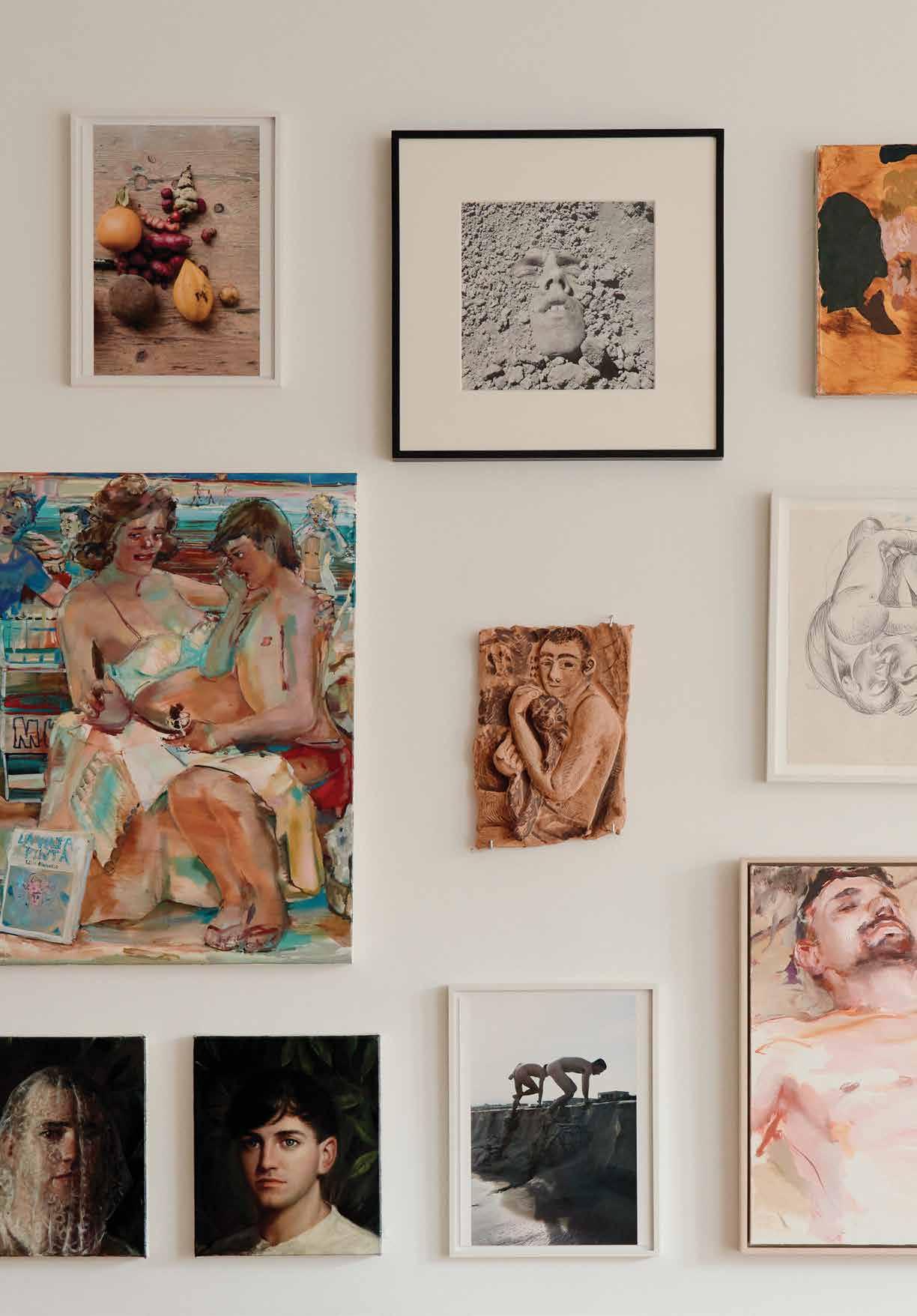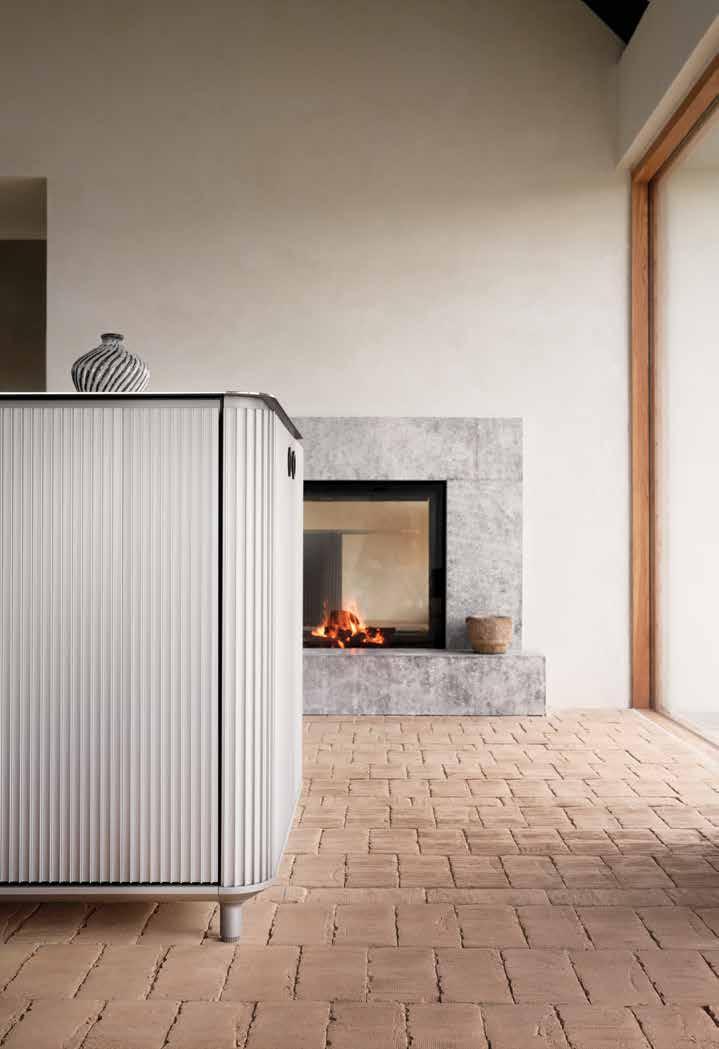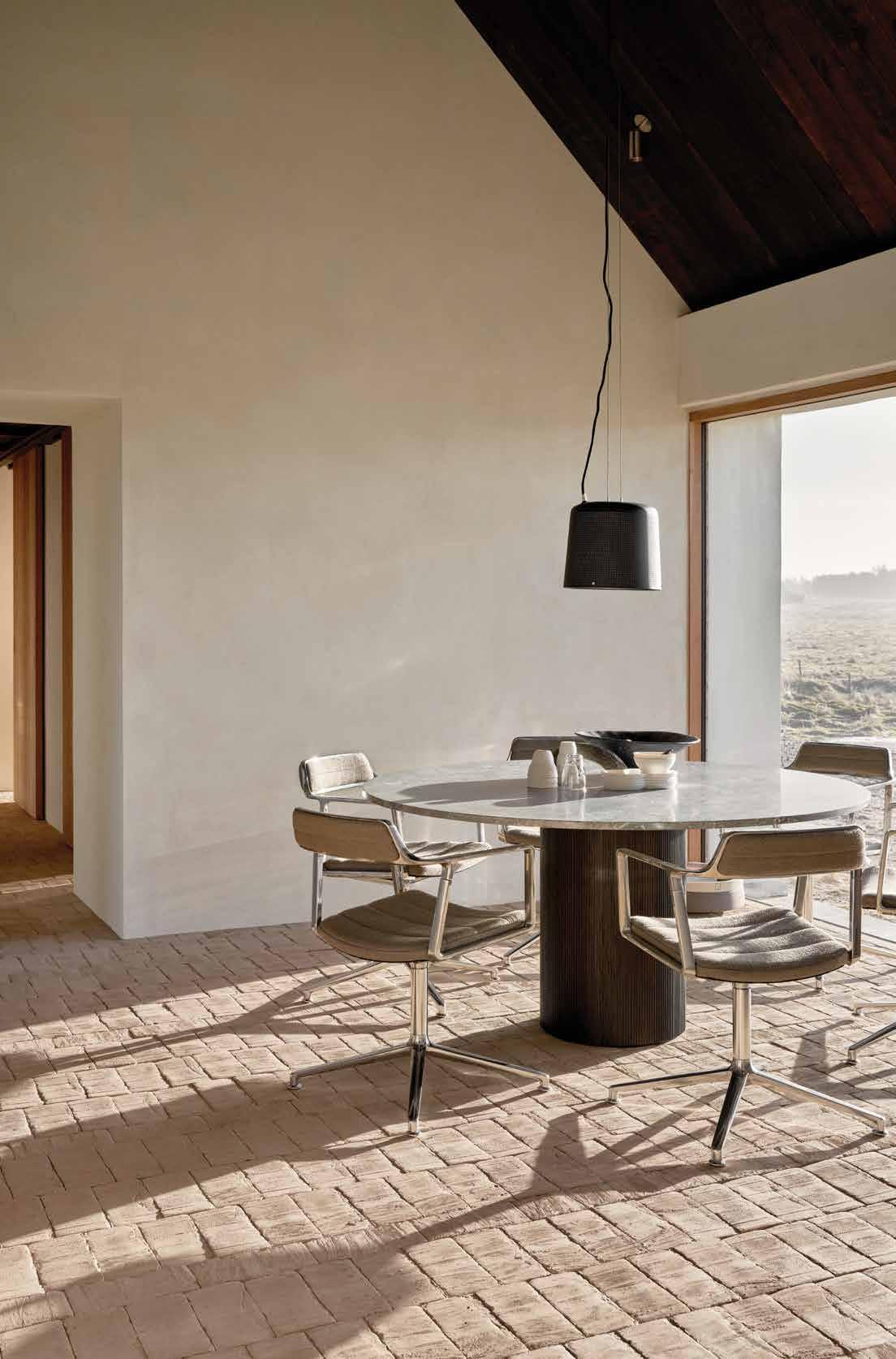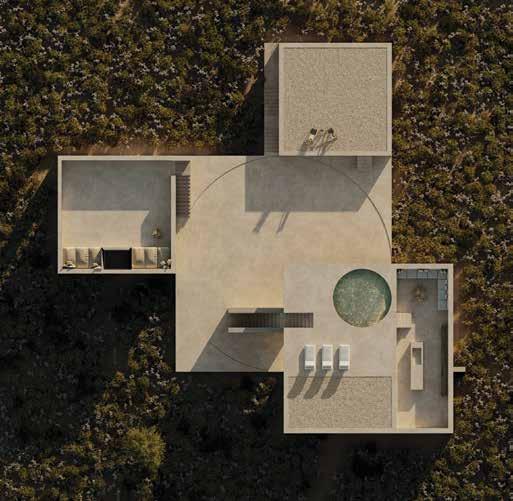
COLD HAWAII
How an old fisherman’s cottage in Denmark’s largest national park turned into a contemporary guesthouse for wave hunters and slow-living enthusiasts. Led by local architect duo Hahn Lavsen and designed to harmonize with nature, a cozy haven amidst Thy’s sandy dunes invites guests to savour the simplicity and beauty of ‘Cold Hawaii’.


SHAPING TOMORROW
“OUR FUTURE IS RATHER DIFFERENT FROM OUR PAST.” LEARN HOW THE DANISH DESIGN BRAND, IS POISED FOR A FUTURE OF BOUNDLESS CREATIVITY AS IT TURNS 85 YEARS.

WHY THIRD GENERATION
VIPP OWNERS LOOK TO LUXURY FASHION BRANDS FOR INSPIRATION.


DESIGN · ARCHITECTURE · FOOD · ART
THE
STAY FOR THE EXPERIENCE. THE HOME THE IDEA THE COLLAB THE PORTRAIT ORIGINAL DESIGN. FORGED FROM HERITAGE Reliable function meets original design in the new V3 kitchen, marking the next chapter in Vipp’s expertise in metalwork. 28 4 16 10
HOME IS WHERE THE ART IS For over a decade, the financial adviser Ilan Cohen has been assembling an intensely personal collection of work by artists from marginalized communities. THE MAGNETIC EDITION Italian artist Alice Ronchi on her fascination with organic shapes and how inanimate objects are personified in her work.
COME FOR
DESTINATION.
VIPP JOURNAL
THE DESTINATION
ISSUE 3
EYES ON THE FUTURE Turning a waste bin into a global design brand is inherently audacious. Nevertheless, that
what
generation
is
3rd
Vipp-owners have intentions of doing.

HAHN LAVSEN A R C H I T E C T S T U D I O
EDITO
What you see is what you get. In an industry where trends come and go, we stand firm in our belief that architecture should be timeless. That is why, we strive to always deliver an honest and tactile experience, both in terms of aesthetics and technicality. With our background in restoration and transformation, we revive old buildings into modern architecture. A signature trait is the use of a limited palette and raw materials, allowing our work to express honesty and offer a minimalist spatial experience. The houses we build should not only be visually striking but also enrich the lives of their inhabitant while remaining in harmony with their surroundings. The Vipp Cold Hawaii guesthouse is no exception.
Throughout the guesthouse, we used a palette of elemental materials: wood, bricks, glass, concrete and stainless steel - chosen for their enduring nature and ability to weather the elements. Embracing the dynamic conditions of the Northern Sea, our design is integrated into its surroundings, whether under the summer sun or the winter storms.
We tried to keep everything as raw and untreated as possible. Look closer, and you will notice that we did not distinguish materials from the exterior to the interior. Rendered walls bear the exact same texture inside and out, while all the wooden surfaces retain their natural rough surface. We envisioned a minimalist experience enhanced by a material honesty and low-tech lifestyle. While it has all the comforts of a modern summer house, it remains understated and in tune with nature.


NOTATION Hahn Lavsen was founded in 2019 by the SwedishDanish couple, Caroline Hahn and Ebbe Lavsen. Situated in Agger, Thy, their architecture studio doubles as their private residence, conveniently situated just a 30-minute drive away from the Vipp Cold Hawaii guesthouse. LEFT: CAROLINE HAHN & EBBE LAVSEN BELOW: HOME & ARCHITECTURE STUDIO
CAROLINE HAHN & EBBE LAVSEN, HAHN LAVSEN STUDIO

HOME IS WHERE THE
THE HOME 4
HOME OF ILAN COHEN

ART IS
VIPP JOURNAL · ISSUE 3
PHOTOGRAPHY WILLIAM
WORDS CHRISTINA HINDING
JESS LAIRD

THE HOME 6

For over a decade, the financial adviser Ilan Cohen has been assembling an intensely personal collection of work by artists from marginalized communities, particularly focusing on queer figuration and abstract art created by women. He dives deep into their practices, inviting them to salon-style gatherings for a meal and a conversation in his art-packed Chelsea home.
Collaborating with architects Noam Dvir and Daniel Rauchwerger of New York-based BoND, Cohen has designed a home of sumptuous sophistication dosed with illuminating juxtapositions of art and design. The airy loft bears witness to his deep passion for art which was sparked in his adolescent years. Few surface inches are left untouched by sculptures, paintings, or by his collection of contemporary furniture.
Purposely white-painted walls allow the artworks to stand out and interact with each other. A giant wall of more than 50 individual paintings creates the illusion of one holistic art piece. After visiting the Vipp Studio NYC in Tribeca, Cohen opted for a Vipp kitchen in a warm grey coating. A custom-made dining table, where he reads, works, and entertains with visiting artists and friends anchors the open space as the spiritual heart of the residence.
VIPP JOURNAL · ISSUE 3
LIVING IN A HOME ADORNED WITH ART EVOKES A PROFOUND SENSE OF ENRICHMENT, WHERE EACH PIECE CARRIES MEMORIES, STORIES, AND EMOTIONS.

THE HOME 8

NOTATION Israeli-born Cohen moved to New York in ‘91 to study film at NYU, residing in East Village and Dumbo pre-gentrification. Despite dropping out and briefly returning to Israel, he permanently settled in NYC. His current New York real estate success story began when, during the pandemic, he discovered his dream configuration at his long-held address, making it his own after years of waiting.
The Chelsea Mercantile, built in 1908 as a woollens manufacturing site, later served as the Veteran’s Administration Building after World War II. Today, it stands as the prestigious condominium “The Chelsea Mercantile”. Comprising four original buildings situated on 7th Avenue, between 24th and 25th streets, it was originally home to The National Cloak and Suit Company, a pioneering mail-order clothing house. Noted for its dramatic early 20th-century limestone facade and beautifully appointed Moroccan tilework, the building offers a grand historical ambiance.
VIPP JOURNAL · ISSUE 3

THE IDEA 10
ORIGINAL DESIGN. FORGED FROM HERITAGE.
V3
Vipp inherited not only founder Holger Nielsen’s entrepreneurial spirit in the form of a robust stainless-steel pedal bin, but also his zeal to create indispensable, durable tools for everyday life. Inspired by this heritage, the first all-metal Vipp kitchen, the V1, was introduced in 2011 and the new V3 kitchen continues the trajectory of the pedal bin that has been made for eighty-five years.
Introduced in early 2024, the new V3 kitchen brings a distinct character to Vipp’s familiar modular kitchen design. The freestanding modules are wrapped in naturally anodized aluminium - with vertically extruded profiles curving around the edges to bring a light elegance to the metallic finish. Resting effortlessly on four legs, Vipp’s design team and engineers have again blended the everyday functionality of a kitchen with the minimalist aesthetic of Vipp furniture.
PHOTOGRAPHY PIA WINTHER HANSEN
STYLING JULIE CLOOS MØLSGAARD

(01)


(02)

(01)
Inspired by the use of extruded aluminium in Vipp’s Chimney House and Shelter guesthouses as well as the Vipp Studio in New York, the elegant aluminium siding has a distinct look and feel, while its underlying design language and 4-millimeter floating stainless-steel countertop draws clear lines to the brand’s heritage.
(02)
“The V3 kitchen allowed us to combine valuable knowhow from our first kitchen with our legacy of metalwork in a visual expression that is both very compelling and innovative. In addition to the functional nature of the modular kitchen, we were able to introduce one of our trademark materials – extruded aluminium.”
KASPER EGELUND, CEO, AND 3RD GENERATION VIPP-OWNER
The edges of the stainless-steel countertop and aluminium siding of the V3 kitchen are rounded to add softness to the industrial material.
(03)
The kitchen cabinets feature discreetly integrated handles, while the fridge and freezer cabinets boast long handles with rounded, rubber inner edges that can manage the weight and pressure of the heavier, air-sealed doors. For an uninterrupted expression and full functionality, the countertop of the kitchen features an integrated sink, fitted with a customized Vipp tap in stainless steel.
(04)
With its seamless support on four legs, the V3 blends the everyday functionality of a kitchen with the minimalist aesthetic of Vipp furniture. Stainless-steel set screws enable easy adjustment for uneven floors, ensuring stability and adaptability.
(04)
(03)



ALICE RONCHI
A captivating blend of functionality and artistry characterizes Vipp’s recent Blank Canvas partnership with Italian artist Alice Ronchi, who has transformed the Vipp pedal bin into a playful artwork. Crafted from metallic coloured steel, six unique magnetic forms mimic the fluidity of seaweed, adorning the polished steel bin. Ronchi’s interpretation of the iconic bin invites you to reimagine the ordinary and infuses it with creativity and wonder.


Q
What is your idea behind the concept?
My idea was to create a series of magnets that could be affixed to the bin, mirroring the popular tradition of placing magnets on the kitchen fridge. Inspired by the shapes of seaweed, I proposed an elegant iteration of these artifacts, inviting people to engage with the bin. The act of throwing things in the bin is often instinctual. By incorporating tailormade magnets, I aimed to disrupt this nature and instead bring focus to the bin – an inherently functional object that tends to blend in with its surroundings. I envisioned the bin as an equal protagonist in the home, rather than just something relegated to a corner.
Q
How does it relate to your previous work?
This project relates to my previous work in terms of its conceptual approach - the idea of considering the bin not just as a canvas for decoration, but rather as a subject in its own right. This reflects my tendency to observe my surroundings in a particular way, often portrayed in my work through poetic narratives where inanimate objects are personified.
Q
Organic shapes are a recurring theme in your art pieces and aesthetic. How come – what do you find compelling about these shapes?
I´ve always been fascinated by organic shapes because they evoke with something natural and primitive that resonates with all of us; they subtly connect us with nature. Over the years, I have developed my own abstract language inspired by these forms, creating an alphabet of shapes that I use to convey different feelings and subjects.
Q
Would you say that the ‘Magnetic’ bin is functional art – can a trashcan ever be art?
I wouldn´t consider the ‘Magnetic’ bin as functional art. The Vipp bin is a beautiful object designed by a talented metalsmith in 1939 – and my intervention did not transform the functional nature of the design. To me art, by definition, is not functional. I would rather say that the ‘Magnetic’ bin is a piece of design that has been interpretated by an artist.
Q
What interested you about collaborating with Vipp?
I liked the challenge of exploring the possibilities of the bin and I have an appreciation for Vipp’s philosophy and industrial-style furniture. There are some interesting parallels in our expressive languages, both characterized by a simple yet elegant aesthetic. This includes Vipp’s choice to use a bin as a means of engaging with other creatives.
Q
Why these vivid colours and stainless-steel bin?
I worked quite a bit on the colouration of the magnets. I wanted them to appear transparent, to generate a feeling of lightness, brightness, and fluidity as though they were floating in the bin’s surface. I decided to play with the mirror surface of the bin - to make the magnets look like they are submerged on the surface of the bin, just like seaweed float seamlessly in the water.
Q&A WITH ALICE RONCHI PHOTOGRAPHY PIA WINTHER HANSEN

THE COLLAB 18
“I´ve always been fascinated by organic shapes because they evoke with something natural and primitive that resonates with all of us; they subtly connect us with nature.”


VIPP JOURNAL · ISSUE 3
COLD HAWAII

The sandy dunes of the largest national park in Denmark, Thy, are punctuated with old fisherman’s cottages. Along this stretch of coastline is a surfer’s paradise dubbed ‘Cold Hawaii’, where local architect studio Hahn Lavsen has transformed one of these historic early 1900 cottages into a contemporary guesthouse for wave-hunters and slow-living enthusiasts. Vipp Cold Hawaii, Thy enters the portfolio of bookable one-room guesthouses realised by the Danish design brand.
The guesthouse exudes a subtle confidence and robustness designed to withstand the elements. Embracing a bold minimalism, the architecture features a limited material palette, honest expression, and intentional rawness. “We kept the original geometry and position with east and west facing gables for wind protection. The west gable facing the sea was once a stable. Farmers and fishermen did not care for the view. The layout was a result of how best to shield residents from the strong western winds”, observes Lavsen.
Walls are constructed from insulated concrete blocks, white-washed inside and out, while untreated Douglas fir lines the roof to withstand harsh coastal conditions. Oak stable doors, a nod to the area’s farming history, provide natural ventilation in each room, and glass walls seamlessly integrate into the facade. Exposed brick floors create a refined brutalist aesthetic, evoking the nearby sandy beaches visible through the windows. Whereas the exterior of the house gains its character from

the rawness of its materials, the interior, overseen by interior designer, Julie Cloos Mølsgaard, is dotted with furniture and objects high in precision and craftsmanship. Cloos Mølsgaard’s involvement from the project’s inception has transformed the shell into a home. The soul of the building has been captured with a refreshingly modern and intimately warm palette of sandy tones and textures inspired by the surrounding beaches, dunes, and cliffs. “I aimed to make the Vipp guesthouse in Cold Hawaii as
tranquil and comfortable as possible, creating somewhere guests would want to stay longer and where they could simply relax surrounded by the untamed nature,” adds Cloos Mølsgaard.
The two-story layout includes three bedrooms, two bathrooms, and a combined living area and kitchen, with a custom fireplace mirrored on both sides of the gable. Glass elements frame impeccable views, directing attention to nature’s panorama, with the Vipp V3 metal kitchen at the heart of the living area.
Like the architects, Julie Cloos Mølsgaard has used a narrow material scheme where wood, metal, glass, stone, and natural woven fibres interweave to create a tailored interior where texture rather than colour creates interest and provides a soothing atmosphere. To underline this reverence for materials, Vipp furniture are mixed with pieces from neighbouring craft shops, vintage finds, and work by local artists.
COLD HAWAII — The 55 km stretch of coastline between Agger and Hanstholm, known as ‘Cold Hawaii’ for its wind conditions akin to those of Hawaii, has seen Denmark’s Thy National Park evolve from a workplace into a modern surf hub, fostering a new Nordic surf culture characterized by cold waves and extreme weather. Klitmøller, with its 31 unique surf spots, hosts the prestigious Cold Hawaii PWA World Cup since 2010, reflecting a departure from traditional surfing paradises and highlighting the sport’s evolving nature.
ARCHITECTURE: HAHN LAVSEN INTERIOR DESIGN: JULIE CLOOS MØLSGAARD PHOTOGRAPHY: MARTIN HOFFMANN LARSEN & PIA WINTHER HANSEN WORDS: CHRISTINA HINDING & LOUISE NORMANN




“When you step out the door, you step into a national park. The sensation of being in a no-mans-land, almost in a moon-landscape strikes you. Like the unspoiled rawness of nature that embraces you upon arrival, the house greets you with an unvarnished straightforwardness”
EBBE LAVSEN, THE ARCHITECT.



THE PORTRAIT 28
EYES ON the FUTURE
It’s hard to imagine Holger Nielsen would’ve foreseen what his modest waste bin would lead to eight decades after its creation. Born as a functional tool for hair salons and doctors’ clinics, the Vipp bin has developed into an icon of Danish design, part of the collection at New York’s MoMA and the basis of an entire design universe. Though it has grown into a global brand, Vipp is still family owned and operated, with Holger’s daughter, Jette Egelund, and grandchildren, Kasper and Sofie, continuing to adhere to the brand’s founding principles.
“We are still trying to stand on the shoulders of our grandfather,” says third generation co-owner and CEO of Vipp, Kasper Egelund. “His design principles inspire us and provide the foundation for everything we do. We have one leg in the past, one in the future.”
However, Kasper admits that the vision for the company’s future is rather different from its past. “Our past is marked by a focus on product functionality - which is something we want to maintain. But as we move the brand forward, the focus will be on more than just function.”
 WORDS KARL BECKMAN ILLUSTRATIONS SIGURD MUHS GRELCK
WORDS KARL BECKMAN ILLUSTRATIONS SIGURD MUHS GRELCK
NOTATION Founded in 1939 by metalsmith Holger Nielsen, Vipp is a Danish company now in its 3rd generation of family ownership. VIPP JOURNAL · ISSUE 3

“Embracing boldness is part of who we are. And it will be at the very heart of how Vipp evolves going forward.”
THE PORTRAIT 30

FROM PRODUCT TO EXPERIENCE
For Kasper, Sofie and Jette, Vipp’s future is centered on a transition from product and function to a holistic brand experience.
“We’ve seen it with some of the family-owned French fashion houses, such as Hermes – beginning with very functional products and ultimately building an entire design experience,” explains Kasper. “We find a lot of inspiration in these brands.”
One of the main focus areas in the evolution of Vipp is the guesthouse concept. What started as Kasper’s bold idea to create a retreat in the Swedish forest has taken off into a collection of accommodations fully curated and furnished by Vipp. “Our guesthouses allow visitors to step into and live in our design universe. It’s not just about the individual products, but about how they are experienced holistically – which is never identical depending on the locale.”
With nine locations across five countries and more on the way, Vipp’s guesthouses are providing new opportunities for how the brand can be experienced. “We will continue exploring new ways the brand can be brought to life,” says Kasper. “In addition to the guesthouses, this means more curated products and experiences.”
A FUTURE BUILT ON BOLDNESS
Despite what the company has become, boldness was not necessarily inherent in Vipp. “Holger was actually rather conservative,” says Sofie. “But over the past 85 years, our family has become more and more adventurous in our ideas and approach to the business.
”Transforming a waste bin into a global design brand is audacious almost by definition. But bold ideas should come as no surprise considering who is leading the company. A social worker with no formal business degree, it was Jette who first had the vision to grow the business by taking the waste bin into private homes and luxury department stores. It’s safe to say she passed this boldness on to her children. Trained graphic designer and the brand’s art director, Sofie made the move to New York City in 2014 to expand Vipp’s footprint and run the company’s US operations together with her husband Frank. And Kasper, who is dyslexic and was pegged “hopeless” in his school years, continues to lead the business to new frontiers with outside-the-box creativity and bold ideas like the guesthouse concept.
VIPP JOURNAL ISSUE 3
MEXICO:









Designed by the Mexico City-based architecture studio PPAA (Pérez Palacios Arquitectos Asociados), this modern bungalow situated on the Pacific coast of Mexico’s Baja California Sur, will debut as Vipp’s tenth guesthouse destination later this year.
NEXT ISSUE VIPP.COM
TODO SANTOS, BAJA CALIFORNIA SUR






































 WORDS KARL BECKMAN ILLUSTRATIONS SIGURD MUHS GRELCK
WORDS KARL BECKMAN ILLUSTRATIONS SIGURD MUHS GRELCK








